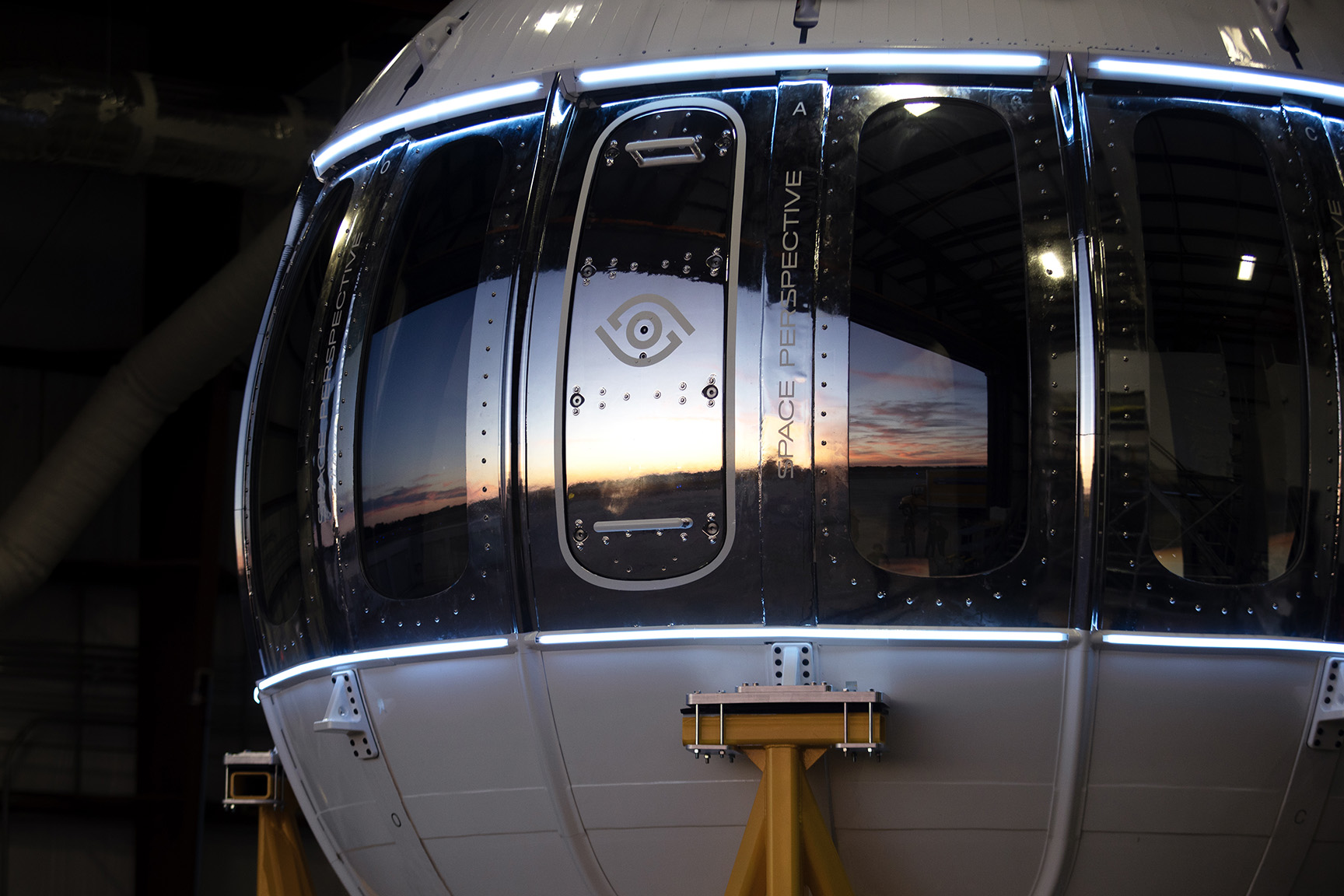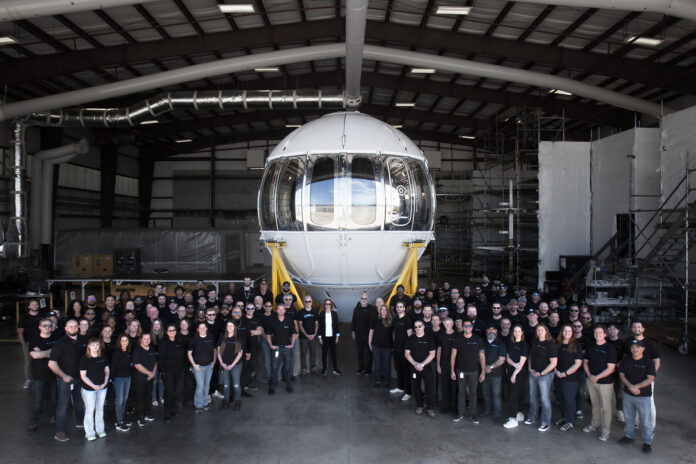Images of its completed test capsule were released today by Space Perspective, the world’s first carbon-neutral spaceflight experience company. With its first SpaceBalloon finished and its launch vessel, Marine Spaceport Voyager, in its final stage of preparation, the company is beginning to eye its test flights window. On a mission to make space travel more accessible than ever before, Space Perspective offers an innovative experience with its Spaceship Neptune, comprising a pressurized capsule propelled by a giant SpaceBalloon™, providing a safe and transformative six-hour journey to the edge of space.

The experience, which requires no rockets, weightlessness, heavy g-forces, or training, is designed to be gentle on Explorers and the Earth alike. Those who fly with Space Perspective, regulated by the FAA as well as the U.S. Coast Guard and following guidelines established by NASA, enjoy amenities such as a world-class meal and cocktail service, Wi-Fi, unprecedented views through the largest windows ever flown to space, and a proper restroom, referred to as the Space Spa, all from the comforts of the world’s first Space Lounge.
Founded by human spaceflight veterans Jane Poynter and Taber MacCallum, who met as original crew members in Biosphere 2, Space Perspective is based on Florida’s Space Coast. Poynter and MacCallum previously launched Paragon Space Development Corporation, known for developing tech for environmental control systems on the International Space Station (ISS). The company’s team has played a significant role in the development of every U.S. human spacecraft for the past 40 years.
The test capsule, named Excelsior in honor of late balloon space-jump pioneer Joe Kittinger, is now the largest spaceflight capsule in existence, representing a significant milestone in U.S. entrepreneurship as the first commercial spacecraft designed, developed, and manufactured without the backing of a billionaire or significant government funding. Soon to be the largest human spacecraft in operation (excluding space stations), Spaceship Neptune’s spherical capsule boasts a diameter of 16 feet (4.9 meters), providing a pressurized volume of more than 2,000 cubic feet (60 cubic meters), roughly two times the volume of Virgin Galactic’s Spaceship Two and Blue Origin’s New Shepard, and about four times that of SpaceX’s Crew Dragon.
The iconic spherical shape of the exterior creates the perfect pressure vessel. Starting with this form allowed the engineers to not only create the lightest and strongest structure possible but also the roomiest interior. Space Perspective also long considered repeated vertical windows, which allow for contiguous panoramic views (vs. horizontal windows, which would bifurcate the view to the human eye – a phenomenon resulting from stereoscopic vision). Its innovative windows were designed to protect from harmful wavelengths of sunlight while also controlling for heat in the capsule and not altering the color of what one sees out of them – the stars above and the Earth below.

More than 100 layouts for the interior of the capsule and its Space Lounge were explored before finalizing the overall dimensions and flow to maximize space and comfort. Designed to accommodate eight Explorers and a Captain, once in commercial operations, Spaceship Neptune will set the record for the most people taken to the edge of space – one more than the NASA Space Shuttle mission STS-61-A.
Every major element of its spaceship is covered by a patent – this includes the SpaceBalloon, the method of launching a SpaceBalloon from a ship, the reserve descent system, the heat-rejecting radiator technology, the capsule structure with vertical windows, and the splash cone, which attenuates the capsule to provide a gentle ocean landing and then becomes a sea anchor to stabilize the capsule.
Space Perspective is distinguished by its vertical integration encompassing in-house capsule design, manufacturing, testing, and operational functions. It boasts a carbon composites manufacturing facility equipped with cutting-edge process control, alongside a material testing laboratory and a capsule integration hangar. Additionally, the company’s in-house capabilities extend to the development and construction of flight electrical and power systems, software, mission control, and environmental control and life support systems. Notably, Space Perspective’s SpaceBalloons are produced in its Seely SpaceBalloon™ Factory, spanning 700 feet, honoring the late chemical engineer and balloon science pioneer Loren G. Seely, under whom the company’s head of balloon development and manufacturing was trained.
The completion of test capsules involved collaboration with reputable operational partners such as Llamas Plastics, Keyence, Siemens, Epsilon3, Dolphitech, ViRTEK, Rescale, Sims Crane, PCI Composites, Andromeda Systems Inc., and RS&H Aerospace Solutions.
The engineering team at Space Perspective has played a pivotal role in the development of every U.S. human spacecraft for the past four decades. Their expertise encompasses collaborations with esteemed organizations including NASA, SpaceX, Boeing, Virgin Galactic, Blue Origin, and the U.S. Navy. Notably, the achievement of the capsule is the culmination of extensive collaboration between three key engineering teams: structures, led by Ryon Warren; manufacturing, led by Vincent Bachet; and design, led by Dan Window. Mitzi Giles and her team have overseen the successful completion of the company’s inaugural SpaceBalloon. Leadership roles are further complemented by John Straus, Ryan Nascimento, Quentin Washington, Curis Larsen, and Al Witkowski, each heading critical aspects of the project.
In 2021, Space Perspective conducted a successful flight of a capsule simulator to 100,000 feet using its SpaceBalloon. Subsequently, the teams have been engaged in designing and constructing a pressurized capsule for further testing. Uncrewed test flights are set to commence off the coast of Florida in the coming weeks, following the completion of spaceship components. Data collected during these flights will inform the development of human-rated capsules and crewed test flights later in the year.
Space Perspective’s innovative spaceflights offer customers, referred to as Explorers, a transformative six-hour journey within a capsule propelled by a SpaceBalloon at approximately 12 mph, providing the most accessible means of traveling to space without rockets or heavy g-forces. The company’s Space Lounge within the capsule offers luxurious amenities, panoramic views through expansive windows, and even a properly equipped restroom dubbed the Space Spa.
Driven by its mission to increase human presence in space, Space Perspective collaborates with NGOs and pursues a carbon-neutral operational plan, aiming to contribute positively to the planet’s future. The company’s vision resonates not only with its employees but also with its expanding community of Explorers, many of whom return from missions with a heightened awareness of environmental and societal issues.

With the luxury experiences market projected to double to $2 trillion by 2030, Space Perspective is strategically positioned to cater to the growing demand for transformative, sustainable, and bespoke trips, particularly among high-net-worth individuals and adventure tourists. As the company prepares to resume test flights, it anticipates fulfilling the aspirations of its over 1,750 current ticket holders and aims to accommodate more than 4,000 seats sold by the end of the year, amounting to $400 million in bookings.
While initially focused on operations in Florida, Space Perspective is exploring opportunities to expand its operations to regions like the Middle East, Asia, and Europe, where there is considerable interest in participating in the emerging space economy and enhancing regional cultural offerings through space tourism and activation.
A seat on Spaceship Neptune is priced at $125,000, while a full capsule, comprising eight seats, costs $1 million and accounts for 50% of reservations within the travel trade industry, which plays a pivotal role in securing bookings.


